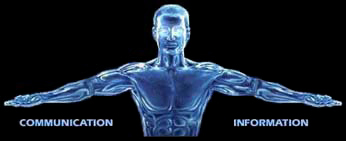Introduction
We encourage you to verify the source images for yourself, rather than just simply accept the facts that are presented here.
Exact details of the used image templates can be found here.
Some reports on this website are based on previous ones. So it is extremely important to read the reports in chronological order.
Details can turn up that have probably already been analyzed in detail. If you are new here and you directly start reading the
recent reports without prior knowledge, then it could happen that the required context is not recognizable.
You do yourself and us a favor when you first start with the oldest reports.
This is the first analysis report on misinterpretations and misperceptions. There are no previous reports. You can continue to read here.
The pareidolia effect
Pareidolia
 is a psychological phenomenon in which a vague and random stimulus, such as a picture or a sound, is considered to be significant
(it could also be a form of a so-called apophenia
is a psychological phenomenon in which a vague and random stimulus, such as a picture or a sound, is considered to be significant
(it could also be a form of a so-called apophenia
 ).
Typical examples are the recognition of animals or faces in clouds formations or the listening of hidden messages in
audio recordings, when they are played backwards. The term is from the Greek words para ("beside, along, instead of"), which
is in this context in the sense of something faulty, something wrong and the noun eidolon - a diminutive of eidos ("image, form, shape"). ).
Typical examples are the recognition of animals or faces in clouds formations or the listening of hidden messages in
audio recordings, when they are played backwards. The term is from the Greek words para ("beside, along, instead of"), which
is in this context in the sense of something faulty, something wrong and the noun eidolon - a diminutive of eidos ("image, form, shape").
Pareidolias are misinterpretations that can be caused deliberately or unconsciously. There is a tendency of the human
brain to complete diffuse incomplete perceptions, and to set them in connection with known patterns and shapes. A certain
archetypal expectation seems to cause that many people often perceive the same thing. This is especially reflected
in the recognition of human faces in chaotic patterns. A kind of natural internal protection function is assumed here.
A skill that help us to relatively quickly detect and recognize faces and hiding people out of the chaos.
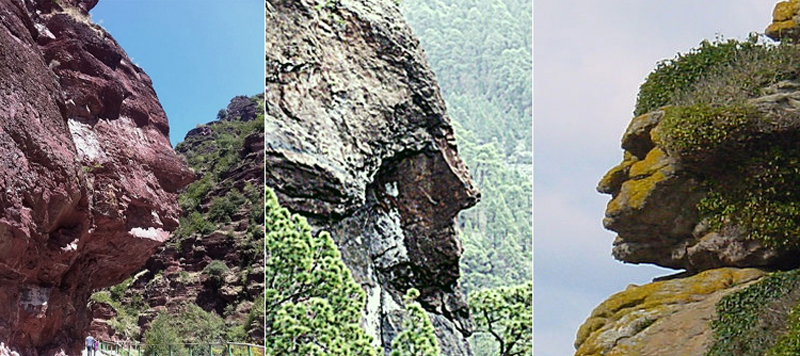
Click to enlarge this image
Therefore it is not surprising that we encounter the phenomenon of pareidolia very often in nature, in areas
that have a variety of chaotic patterns. For example, on rock walls. Some of these structures are also interesting
points of interest for tourists because due to their particular characteristics.
Insofar the well-known Mars face in the region of Cydonia has to be considered clearly classified as pareidolia. If it
is expected that Mars has always been a "dead" planet, then the sighting of a supposed giant stone face can only be one of
those phenomena in which natural geological processes have accidentally created a structure that amazingly have many
similarities with a human face.
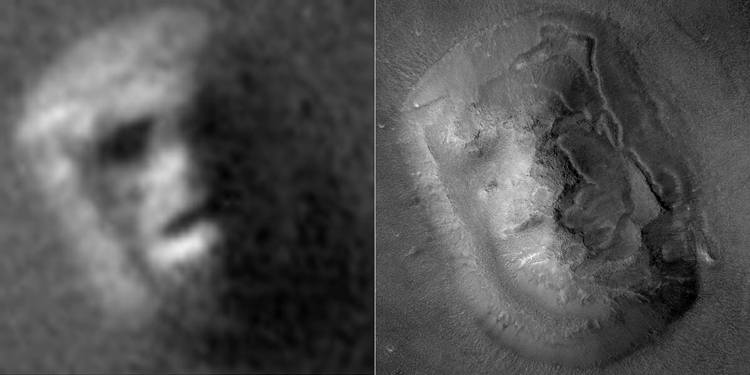
Click to enlarge this image
However, wether the preceding assumption corresponds to the facts, is another matter. With regard to the issue of
"illusions and misinterpretations" this aspect plays no role. The recent high resolution images convey
much less the impression of a human countenance, as the old Viking images suggested. This can in turn be counted
as a further argument in favor of the pareidolia effect.
Nature as a creative force
The creative power of nature is too easily underestimated. The possible results seem in some cases to act
creative to the human perception and to convey the impression of an almost intelligently controlled force. However,
it is a completely natural phenomenon that in dynamically changing structures a seemingly meaningful context inevitably
arise from a chaotic pattern
A very good example of random natural creativity is the so-called "Medicine Man" or "Indian Head" in Canada. There appear not
only basic anatomical features such as the eyes, eyebrows, nose and mouth, they are also placed correctly. Abstractly
represented further details, like the neck and shoulders, can be recognized. As well as a kind of headdress, remotely similar
to the headdress of Native American cultures.

Click to enlarge this image
Just as it is the case on earth, highly meaningful structures can arise naturally. According to the probabilities there must
be necessarily countless examples of different structures on the Martian surface that are susceptible to the pareidolia effect.
Those who are not aware of this fact and never consider the possibility of a natural structure into
consideration will ultimately chasing his imaginations.
The conclusion from these examples should read that not everything that looks like faces, animals, or people, must
necessarily be an artificially created entity. For this reason, there must be more evidences than just similarities. The
example of the "Medicine Man" shows that we must set the bar high. Namely, very high up.
Optical illusions
A flying stone on Mars? Here is an example, which is still listed on the Internet from various sites as an evidence of mysterious
physical forces on Mars. In the following screenshot three examples from different sites are listed.
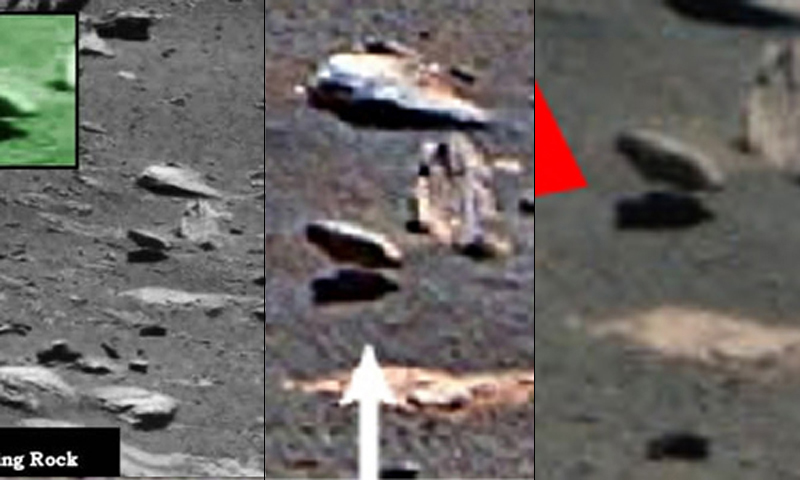
Click to enlarge this image
The screenshots are based on an image of the Mars rover Opportunity, taken with the panoramic camera on Sol 900. Amids
the vast wilderness, in a region that seems not to be remarkable, a stone abruptly arises from the ground.
Actually, you should be asking why, contrary to the laws of physics as we know, a single stone just hovers
above the ground. Why does it affects only one stone and why does it occur in a completely unobtrusive area? Even for an
unprejudiced observer, who is open to any theory, numerous inconsistencies arising at first consideration. Nowhere on
earth one can observe a comparable phenomenon.
Is it possible to accuse us blinkered thinking if we consider that the possibility of exotic physical phenomena on other
planets is unlikely? No, it is just a completely prosaic view of things based on our experience and general knowledge of physics.
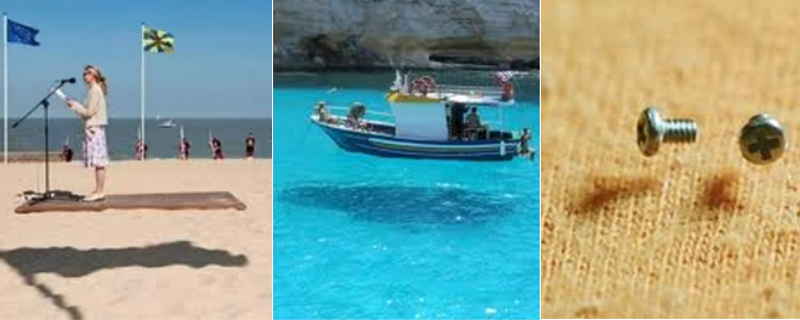
Click to enlarge this image
Whether flying carpet, flying boat or flying screws, none of the shown objects actually flies. It is already enough to place a
slightly darker stain a bit away in front of an object that has a vague resemblance of the dimensions and the shape.
This alone is enough to steer our perception of things in the wrong direction. We first interpret such dark areas from other objects
as shadows of higher-lying objects and do not expect that the dark stain and the corresponding object are on the same ground level.
Keeping these examples in mind, it is much easier to expose the flying rock from Mars as a similar optical illusion.
Focusing on just this one object, has an fatal effect. Without the holistic context, the viewer is missing important points of
reference and environmental features to interpret the presented image spatially correctly.
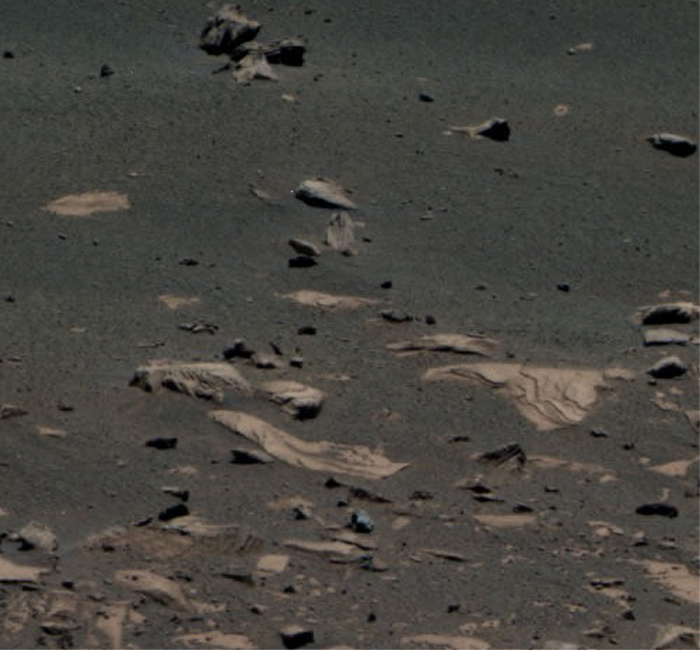
Click to enlarge this image
With only the completely unobstructed view of environment, in which the stone is, other important features can be detected.
There exist namely many further locations that have the same dark area. Due to the present angle, in most cases, the other
dark areas can be assigned as shadows of small stones, wherein the direction of the shadows are always the same.
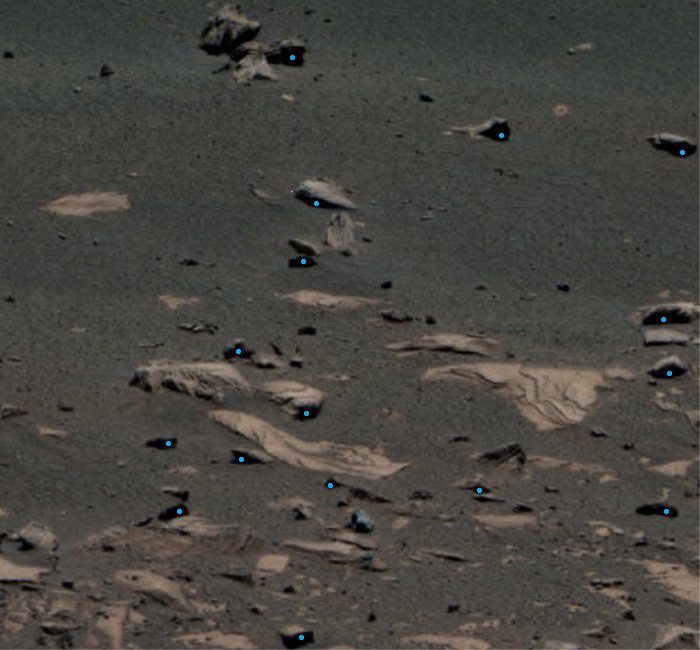
Click to enlarge this image
This image features permit a new perspective on the situation and allow a new and more meaningful interpretation. The darker stain
is therefore not located below the supposedly flying stone. The stain, what is much more likely, is just a bit away in
front of the stone. There is a second stone, which presents us from our point of view only his side facing away from
the sunlight. As shown in the above examples of optical illusions, a dark stain in the appropriate position can causes the illusion
of a flying object.
Image artifacts caused by compression procedures
It is a feature of lossy compression that at higher compression ratios block-like structures appear on the images.
Also the recordings of the Mars probes and rover run through a lossy compression before they are sent to Earth. A problem
with these so-called compression artifacts
 is the fact that they can easily give the impression of artificiality. Under certain circumstances block
artifacts can create straight contour lines that are similar to the features of a building. However, these block formations
reflect a fundamental characteristics of JPEG-Images, where each image is divided in 8x8 blocks (quantization)
and each of them is compressed separately. This aspect is even more problematic by extreme magnification of such images that
had already contained a number of image artifacts.
is the fact that they can easily give the impression of artificiality. Under certain circumstances block
artifacts can create straight contour lines that are similar to the features of a building. However, these block formations
reflect a fundamental characteristics of JPEG-Images, where each image is divided in 8x8 blocks (quantization)
and each of them is compressed separately. This aspect is even more problematic by extreme magnification of such images that
had already contained a number of image artifacts.
An example of such a misinterpretation shows the following image. Within the marked area an allegedly artificial
structure can be seen:
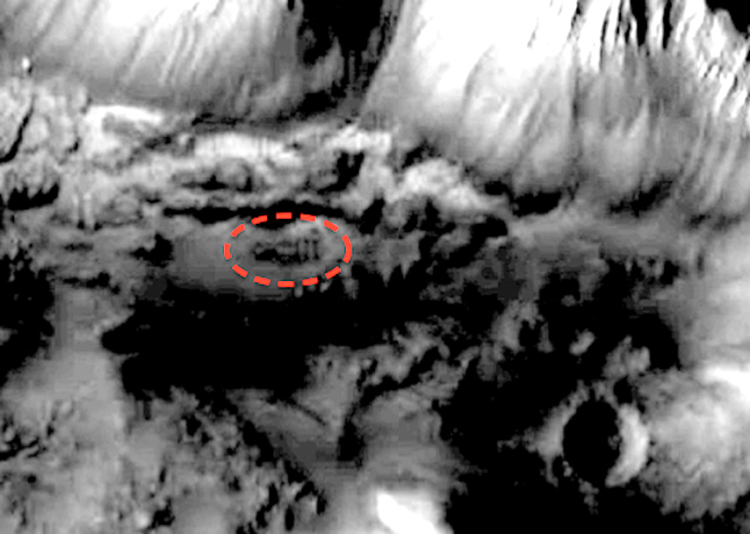
Click to enlarge this image
The image has been enlarged by several factors and significantly contrast enhanced. It is based on a recording of Themis camera
on board the Mars Odyssey probe and shows an area of Tithonian Chasma. It is already futile, trying to find potential candidates
for structural abnormalities using images with very low pixel resolution. Moreover, the
least concerned with the effects of lossy compression.
It may also be an example of selective perception that often only partial aspects are considered in more detail and the
overall picture fades into the background. However, an examination of the overall image contains important information
giving indications on a repeating pattern. To access the different views, please click several times on the following
picture window.
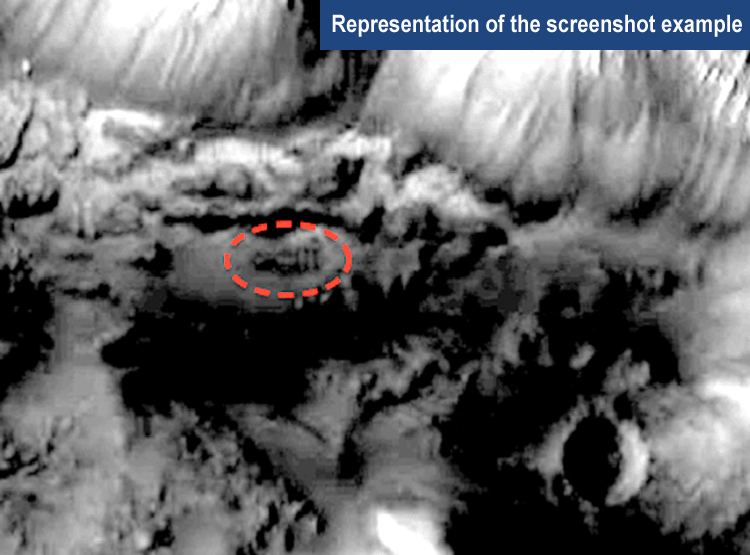
Click on the picture to bring up a new view
The image analysis reveales that the marked structural anomaly is a result of the effects of lossy
image compression. The repetitive lines within the highlighted area are exactly located within a
quantization block. Because of this line structure the impression of an artificial structure is given.
The adjoining part to these lines is basically completely unobtrusive and receives only in connection
with the repetitive lines a supposedly relevant sense.
In the present case, this effect can be defined by the term "vertical ringing". There are wavy line-like features
that arise within the 8x8 quantization blocks and can not only occur vertically but also in a horizontal form.
If you look closely, you can find both types of artifacts in the original image at a
number of places. Due to the relatively unfavorable contrast enhancement, the blocking artifacts are
difficult to detect. Because of the selectively directed perception, which puts the focus on the red area,
the viewer misses another important image information.
In high contrast images the effect can be easily reproduced by using low compression level, as the following
example shows:
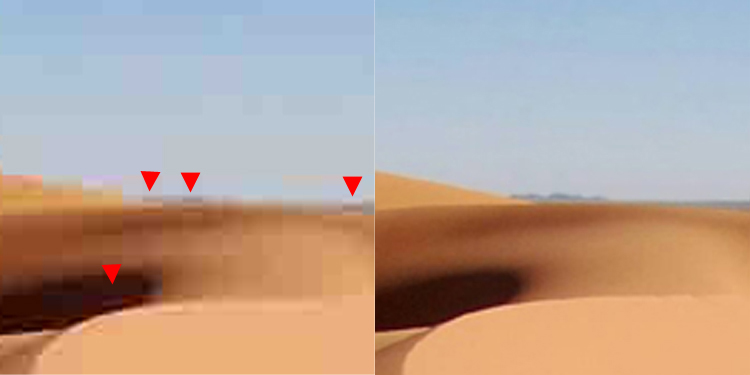
Click to enlarge this image
Due to the very low rate of compression in the left image part, the quantization blocks occur very clearly.
Some of these blocks show the image artifact types, we already mentioned, here in the form of repetitive horizontal lines.
The catch with the resolution
Fatal misjudgments can arise in the consideration and interpretation of images in which a low-to-meter pixel resolution is present.
Thus, the following Viking record of the Cydonia region have become legendary. They gave many viewers the impression of a giant
stone face and a cluster of heavily eroded pyramids.
However, the comparison of these structures with newer probe images, taken with camera systems that have a higher meter per pixel
resolution, show a much more prosaic picture of this area. A click on the titled structures in the map image calls a view
with a juxtaposition of the Viking record and those of the Mars Global Surveyor probe:

Click ob the respective structures to obtain a detailed view
|
Particularly revealing is the view of the so-called "fortress". On the Viking record this structure looks as if you could
partially see into a large dark interior, surrounded by thick walls with sharp edges. However, the detail view that the
MOC camera of Mars Global Surveyor probe provides, shows a completely different picture. No trace of walls or interior chambers.
This shows a complete misinterpretation of the originally suspected shaping.
Another example from the Internet assigns the structures within a crater in the northern part of the Terby crater the
meaning of a planetary basis. In the following figure, evidence of artificiality is derived from the geometric structures.
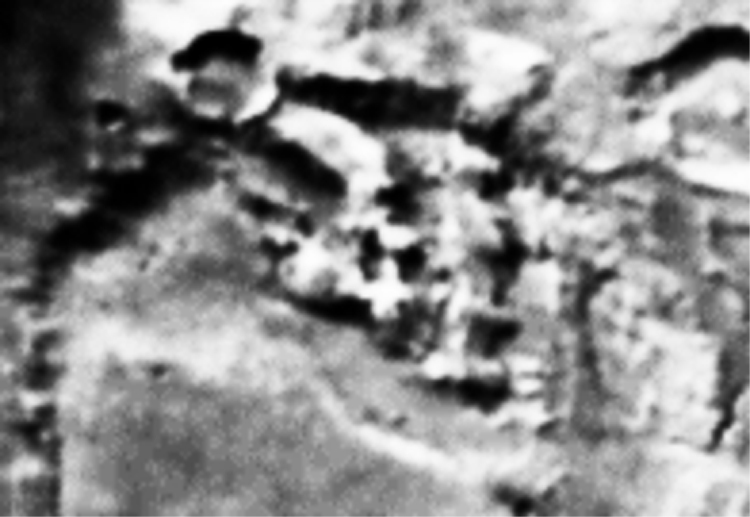
Click to enlarge this image
The image shown here is again an enlargement of a Viking recording. The first impression, viewing this image, is quite
remarkable. Structures can be detected having right angles at several places and many straight lines. The psychological aspect has
already been mentioned and so you will be tempted very quickly to see geometric arrangements. However, what one can not deduce
from this recording are the size dimensions, and in this case they are pretty huge. The faded red circle encircles an areal
having a diameter equivalent to about 69 kilometers.
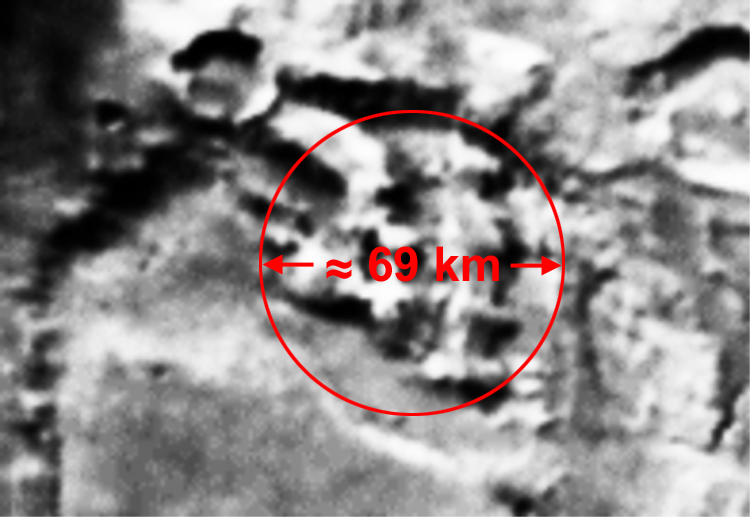
Click to enlarge this image
From a distance, many things look very different than up close. This statement may sum up the substantial core points. If an area
of several tens of kilometers is mapped to a few centimeters, then there is no need for any statements about the real shaping of
the area under consideration. It is not possible to make any binding statements on this basis. Even the scope for speculation is just too big.
The consideration of this area with images that have a much higher meter per pixel resolution, derived from the HRSC camera on board
the Mars Express probe, can neutralize the impression of man-made raised structures entirely. There is nothing more to see of right
angles and straight formations.
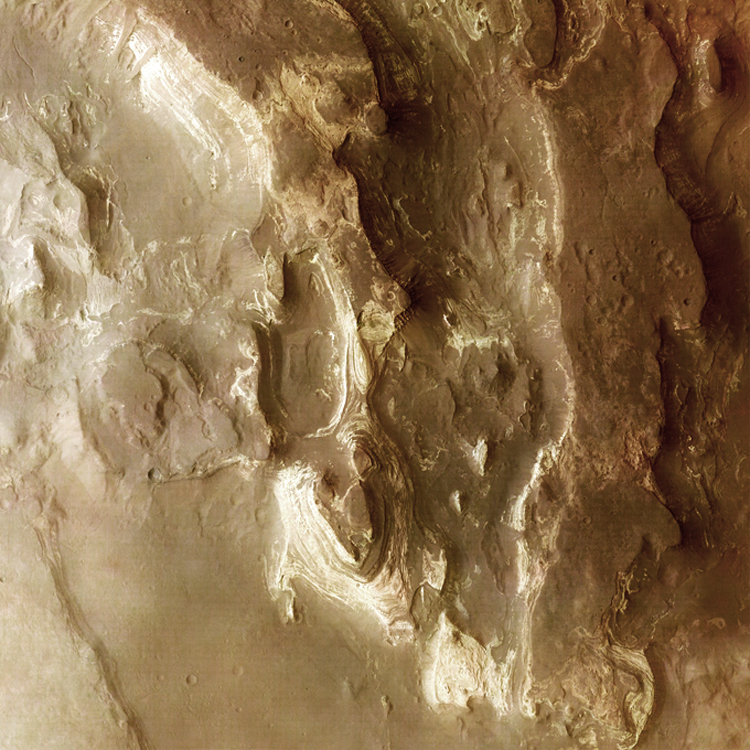
Click to enlarge this image
The direct comparison shows the similarities in the shaping contours between Viking and HRSC recording:
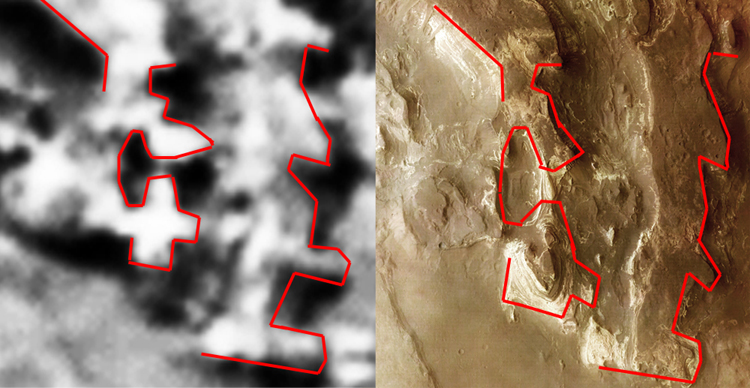
Click to enlarge this image
While coherent structures are visible on the Viking record, the HRSC recording shows that many areas have large differences in
height and interruptions. Impressions of large compact formations, however, are caused on the Viking recording in many areas by
extensive bright layers of rock.
Another view with tilted perspective also allows a spatial view of the area. The HRSC stereo camera system had already
received a part of the areal shown with a resolution of approximately 13 meters per pixel. The data were acquired at
approximately 27° south and 74° east longitude. The sun illuminates the scene shown below from the west.
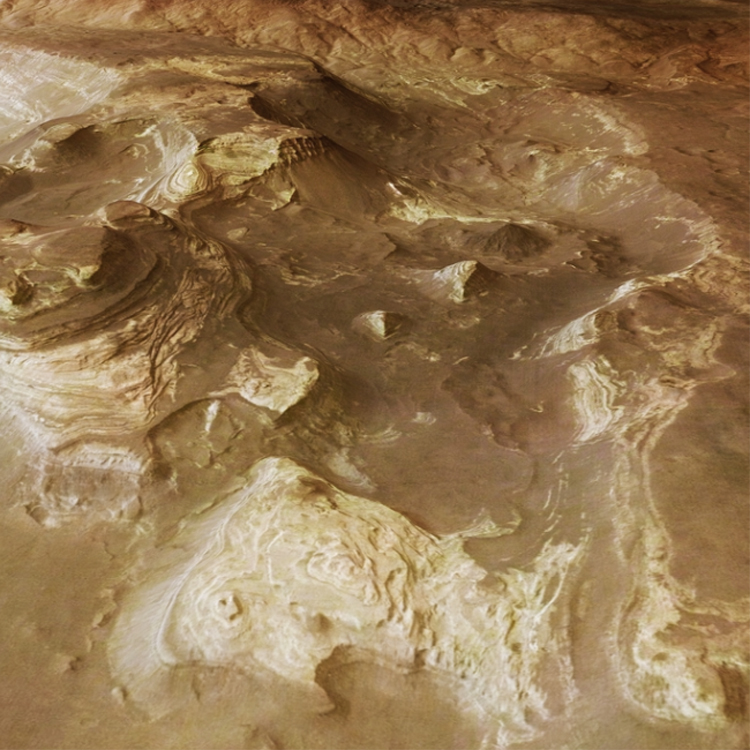
Click to enlarge this image
Our continuous comparison of shots that different probes have delivered to the same area, provided us important empirical data.
These comparative studies have led to the realization that it can be absolutely disastrous to try to excatly interpret structures using
images whose resolution is far beyond 3 meters per pixel. Examples that can be found on the Internet, show interpretation attempts of
people who claim to have found supposedly artificial structures on old Viking shots - but the images with the best pixel resolution of
the Viking probes was equivalent to about
43 meters per pixel  !
Some other interpretation attempts are set beyond 100 meters per pixel and beyond. !
Some other interpretation attempts are set beyond 100 meters per pixel and beyond.
The attempt to detect building structures on such a probe recording, just because they apparently show several square edges on an object
is with a chance of nearly 100% a misjudgment. It is essential for image analysis to collect empirical data regarding the variability of
structures at different pixel resolutions. This can only be done by investing the effort to constantly identify all the available recordings
of all probes to a specific target area and to juxtapose all these images. By doing so, you will be able soon to assess much better the
conditions under which the shaping of a structure can be derived to a certain degree.
Possibilities for image analysis to expose misperception
The Gorilla on Mars
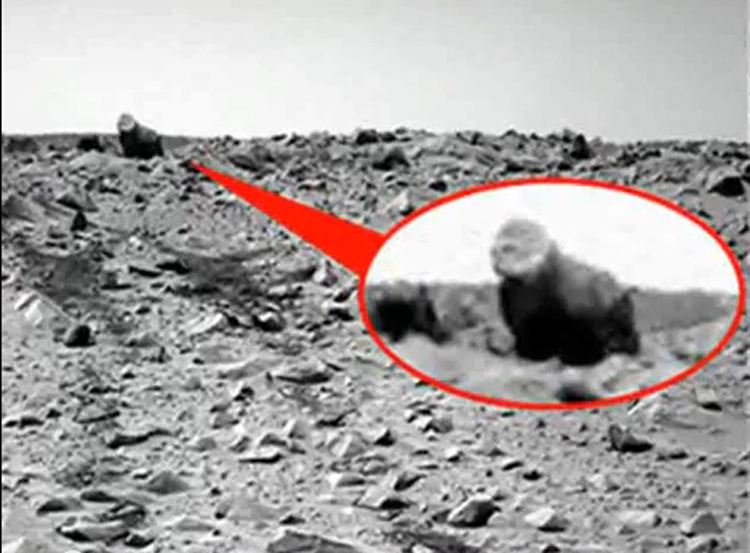
Click to enlarge this image
The shown image section is based on a recording of the Mars rover Spirit, which was taken from the NavCam stereo camera
on Sol 87. There are a number of web pages that refer to this image and also in video portals such as
YouTube you can find a variety of documentations to this finding. Even the popular press was enthusiastic about
this discovery, which acknowledged this issue few years ago as a small entertaining supplement in the category of curiosities .
This discovery was never taken seriously, but to this day the "gorilla" in certain circles is listed as another
piece of evidence for life on Mars.
The highly hostile environmental conditions on Mars appear to play no significant role, if they are known to the relevant persons.
At this point one has to wonder whether wishful thinking or a certain expectation can make an objective consideration of the facts
nearly impossible. With a little more research work it can be determined that this "Animal" was recorded completely unchanged
by the Spirit Rover on Sol 87 up to three times (or six times because of the stereo camera system) within a period of about an hour.
A few who were aware of this fact, changed their views, at least in the sense that it surely had to be more like a statue of a
gorilla-like creature than a living organism.
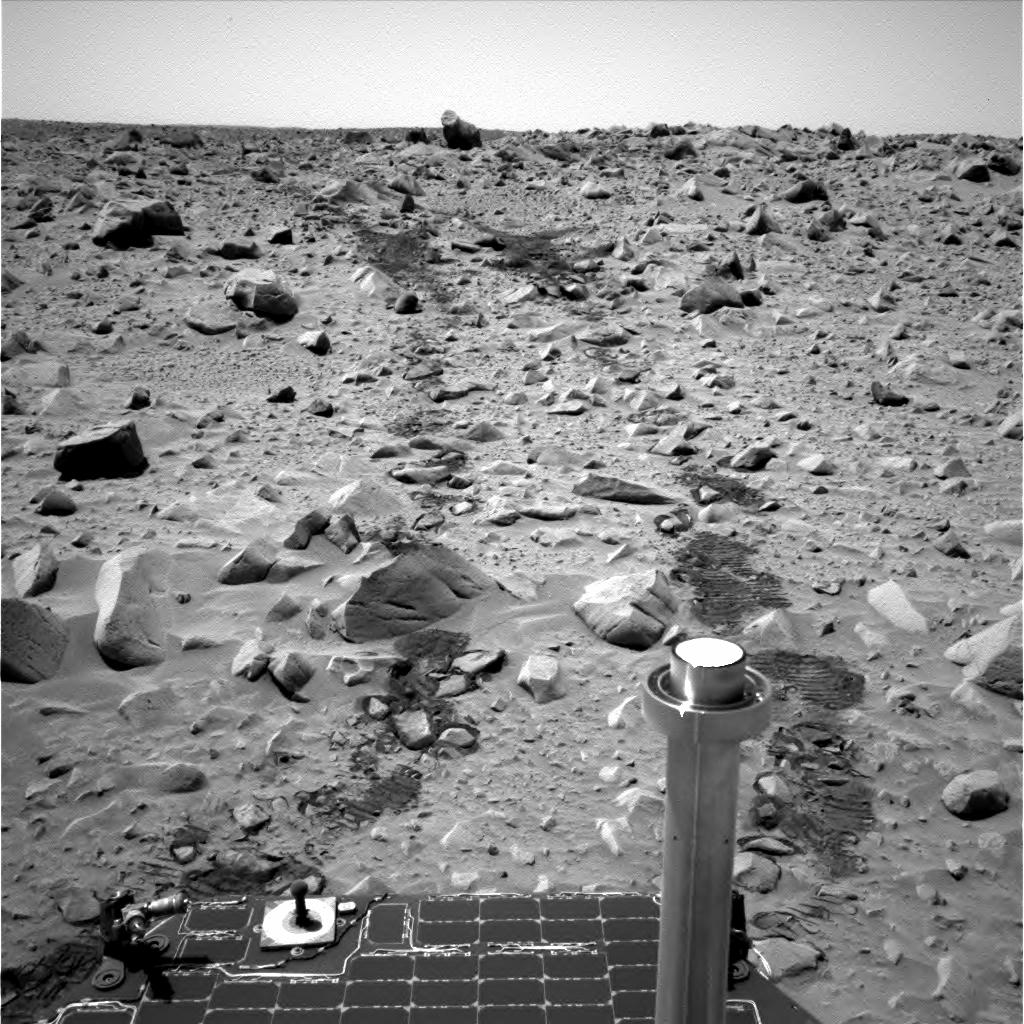
Click to enlarge this image
Helpful for other elucidation approaches is the fact that wheel tracks of the rover are visible on the original recording.
Based on the track direction it can be derived that the course of the rover must have passed by the said object.
Therefore it is possible that recordings of the gorilla stone before Sol 78 are available. In regard to the possible time period,
one can anticipate here that no unusual structures can be found in the officially published photo archive of the Spirit rover.
There are only a few larger stones present on the recordings. This in turn raises the obvious assumption that possibly only a
game of light and shade, together with the pareidolia effect, have let the viewer to believe, to recognize the shadowy figure
of a gorilla-like being. The challenge now is to find a method of proof of this assumption.
How can we comprehensible and convincingly demonstrate that one of the larger pieces of rock on the earlier recordings
is responsible for the misinterpretation.
In this case, photogrammetry
 can provide a solution.
By photogrammetry, it is possible to calculate from a series of photographs that show an object or a particular area from different
angles, a three-dimensional model respectively a three-dimensional model environment.
can provide a solution.
By photogrammetry, it is possible to calculate from a series of photographs that show an object or a particular area from different
angles, a three-dimensional model respectively a three-dimensional model environment.
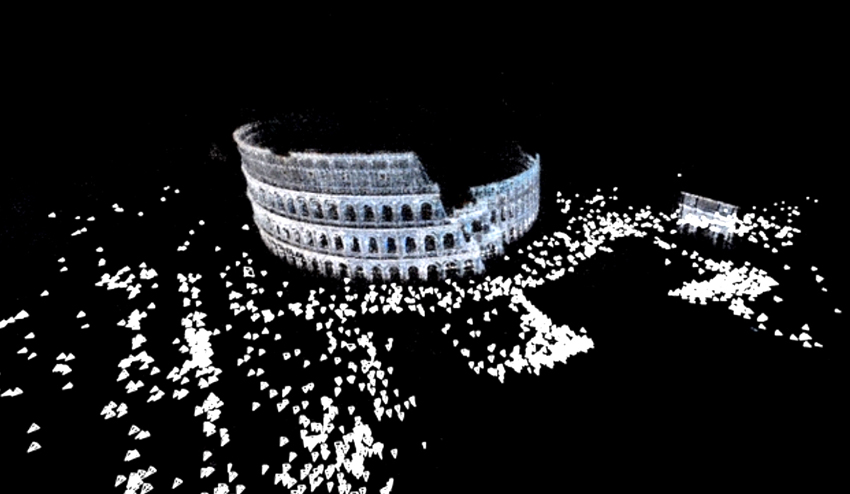
Click on the image to display the animation
The set of all available recordings provide the basis for calculating a so-called point cloud, from which the 3D model is derived later on.
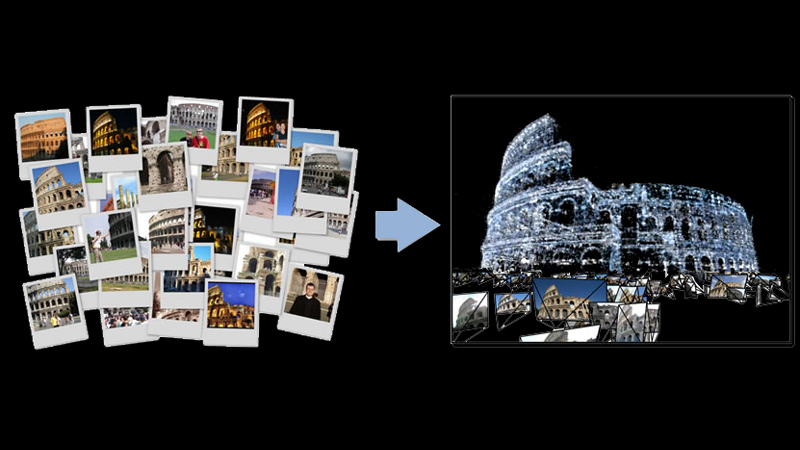
Click to enlarge this image
It is a method that lends itself for the recordings of the Mars rover. Due to its stereo camera system, there are often
two images available with slight offset angle to one scene. As the course of the rover is documented on so-called "Traverse Maps",
one can reconstruct in this specific case, that the rover not only must have passed the suspect object, but also must have been
able to take images of the back of the postulated gorilla statue days earlier. There is a very descriptive
analysis report by Doug Ellison, founder of the discussion forum page
unmannedspaceflight.com
by Doug Ellison, founder of the discussion forum page
unmannedspaceflight.com , where photogrammetry was used for this specific anomaly.
, where photogrammetry was used for this specific anomaly.

Click to enlarge this image
The black areas behind the individual stones represent viewing shadows, because you obviously can not look behind a stone from the perspective
of the camera view. However, by providing images of the back side, these recordings can be added to extent the 3D model, making the overall
picture more complete and thus a free walking through the area is possible. The more images are available, the more realistic is the
calculated 3D model. But even with the limited footage we got from the rover, a convincing result can be already achieved in this case.
A spacial impressions gives us the following animation, with a view around a rock which is suspected to be the alleged gorilla stone.
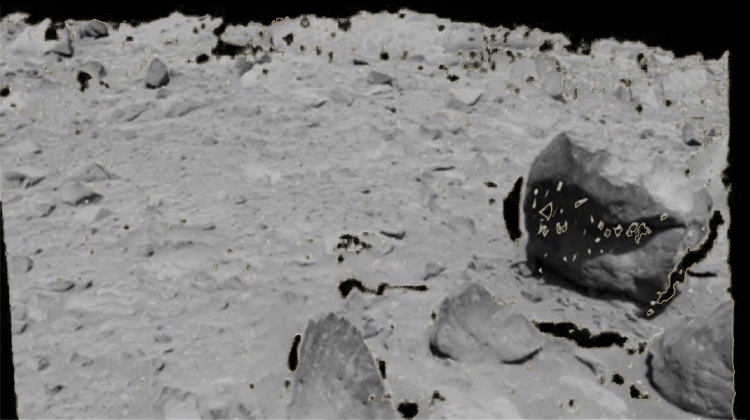
Click on the image to display the animation
Viewed from immediate vicinity this rock looks completely above suspicion. Considering the 3D model in relation to the view
direction of the rover camera on Sol 87, results in the following view:
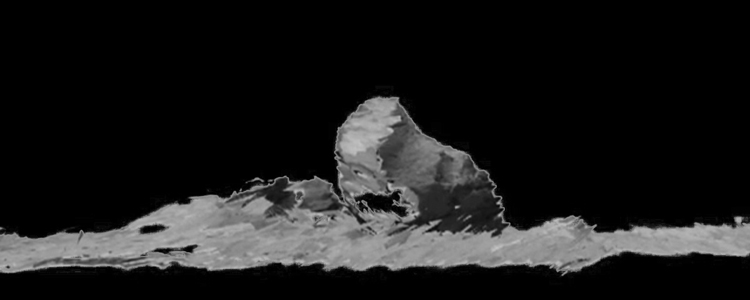
Click on the image to display the animation
The calculated 3D model shows us from this angle an astonishing similarity to the outline shape of the Gorilla.
If we put this model also in relation with the distance to the rover, it allows the direct comparison between the model and
the original recoreded image.

Click on the image to display the animation
Although only few shots were available for the spatial simulation of a very narrow range from the period before Sol 87,
they are sufficient to resolve a large part of the visibility shadows and thus to generate a 3D model that can be viewed
from all angles.
One hundred percent accordance with the original image of Sol 87 is a priori not possible because of the limited environment
information. The comparative review may therefore be limited only to the area that is imaged by the calculated 3D model.
Here it is possible to find significant similarities with distinctive ground characteristics in the mid section area.
The geological characteristics of the 3D model in the comparison test prove to be consistent with the rover recording.
However, the most important statement is the fact that, using a completely natural stone chunk, the same shaping features
can be generated with the Gorilla shape.
Overall, one can speak here of a rather convincing and very well understandable procedure, which allows us an independent
audit and adjustability of the results at any time. As a final result the gorilla turns out to be a completely natural boulder.
A play of light and shadow and the ever-present pareidolia effect favoring the misinterpretation of this structure.
Conclusion
The example with the Gorilla stone shows very impressive, which amazing opportunities arise from photogrammetry. It is
natural to apply photogrammetry to a variety of other examples. For future image analyzes, we will use this method
in appropriate cases, to create own 3D models.
While in the examples in the chapter "Image artifacts caused by compression method" a technically related image effect is present,
misinterpretation of structures is a purely subjective performance. This shows that the psychological aspects that go hand
in hand with the interpretation of images, should never be underestimated. In addition, it is imperative to know in a
comprehensive manner all possible technical confounders in camera technology, image processing and data transmission.
Otherwise, the probability of a blatant misinterpretation can never be ruled out. Knowledge of these confounding factors
is an important prerequisite for a reliable image analysis.
|
